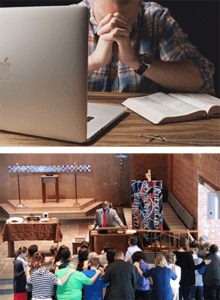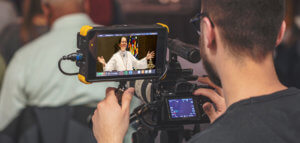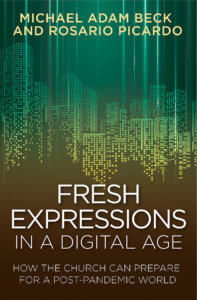How can a church develop hybrid ministry that connects both with those in the room and those who will never enter your church building? Ann Michel of the Lewis Center staff interviews Rosario Picardo, one of the authors of a new book on ministry in the digital age. They discuss how churches can continue to develop online ministry while resuming in-person ministries in the post-pandemic age.
Listen to this interview or continue reading.
Ann Michel. We’re in a time when so many churches are either resuming more in-person ministries or they’re at least looking forward and planning for a time in the not-too-distant future when they can resume in-person ministries. There’s a lot of talk about a hybrid approach combining both in-person and digital ministries. And I think one of the most helpful learnings in your book is that it’s a mistake to think about going back to doing in-person the ways that we used to do it, and then just trying to layer digital ministry on top of that. So, I wanted to give you the opportunity to discuss a different approach to hybrid ministry, to think about what a more effective approach to hybrid ministry might involve.
Rosario Picardo. Yeah, that’s a great question that everybody is wrestling with right now. And I think there are a few different categories of folks. The first is those pounding on the doors of the church who want to get in and worship right away. The second is those that are more reluctant to come. Once there’s a vaccine, and the vaccine is more widespread, they’ll come back. Then, there is a third set that may never venture back as much. They may be very infrequent, but they’ll possibly worship online.
So, living into a “both/and” world with hybrid is interesting. Prior to the pandemic, churches were streaming their worship. But the livestream worshiper was more or less “worshiping over somebody’s shoulder.” It was really geared toward the folks in the room. And the folks out of the room or online were treated more as an afterthought, if you will. The pandemic really made the online viewer a priority, and they’d never really been prioritized prior to that. Especially as pastors and teachers and worship leaders were leading from their homes and from non-traditional spots, it created an atmosphere of community. It actually created an atmosphere of “living room worship.” And so as more in-person worship and other activities resume, the reality is we’re going to have to think in a both/and world.
We have to make a decision. Is worship going to be for those in the room? Or is it going to be for the person viewing? Or is it going to be both?
So how do you continue to incorporate the learnings from the pandemic with technology and interaction but also be able to minister in person? That impacts not just Sunday morning worship, but it also impacts discipleship and small groups and the things that happen during the week. So, I see hybrid actually creating a few different streams. It’s going to relate to people that maybe don’t feel comfortable coming back any time soon. It’s going to connect the church to the greater community. Oftentimes, those that are considering coming to church or maybe they’re looking at new churches, they first come across your website or also worship online to get a feel for it.
So, we have to make a decision. Is worship going to be for those in the room? Or is it going to be for the person viewing? Or is it going to be both? So, a hybrid approach will definitely have to be considered, I think, moving forward.
Ann Michel. I think you also make the very important point that as churches move forward into a both/and hybrid world, what they do in their in-person, sanctuary worship is going to have to change and evolve, too. What are some thoughts you have about that?
Rosario Picardo. Yeah, I think we need to consider the length of the sermon. I love to preach, but I knew that preaching online, I couldn’t preach the same length because a twenty-five or thirty-minute sermon wasn’t going to cut it for an online platform. So, I think we’ll see shorter sermons, getting to what’s important and saying it in fewer sentences. I also think creating engagement will be critical in online worship — but also in person. How do you create the level of engagement? If you’re preaching, when you’re welcoming folks and thanking them for being there, you have to talk to both the camera and to the people sitting in the pews or the chairs in the worship center. I think even the music you play and the length of music. Some things don’t translate to video. When communion is taking place, how do you have a hybrid expression for the folks that are tuning in and watching from their homes? So, pastors and churches are starting to talk about this: how do we create those different experiences that can translate cross platform, whether it’s in-person or online? Then, how do we create community? That is the biggest question. Something that we’ve done is create a “Zoom party,” a Zoom gathering right after worship for those worshiping online to come together. And we’re treating it almost as if it’s one church with a few different services or campuses, if you will. We’re treating online worship pretty much as its own campus. But there’s a philosophical decision that needs to be made. Is online worship for the person sitting in their homes that will never come through the doors of your church? Or is it for the insider that can’t be there? So, you have to start with your “why.”
 Ann Michel. You know, going into the pandemic, there were some churches that were lucky enough, I guess, to already have existing online ministries and they already were livestreaming their services. But I think this experience of worshiping online during the pandemic has really revealed some of the flaws and the shortcomings in the way churches did livestream worship in the pre-pandemic period. You talk about online worshippers having to “look over the shoulders of people who are in the room.” I think you used the words “second-class citizens” in the book — it’s not really about them. They’re just sort of getting the opportunity to peer in. And the whole goal was to eventually lead them to come in person. And that may never happen. Maybe it shouldn’t even be the expectation if we’re thinking about a truly hybrid future.
Ann Michel. You know, going into the pandemic, there were some churches that were lucky enough, I guess, to already have existing online ministries and they already were livestreaming their services. But I think this experience of worshiping online during the pandemic has really revealed some of the flaws and the shortcomings in the way churches did livestream worship in the pre-pandemic period. You talk about online worshippers having to “look over the shoulders of people who are in the room.” I think you used the words “second-class citizens” in the book — it’s not really about them. They’re just sort of getting the opportunity to peer in. And the whole goal was to eventually lead them to come in person. And that may never happen. Maybe it shouldn’t even be the expectation if we’re thinking about a truly hybrid future.
Rosario Picardo. Exactly. If it’s a hybrid future, I have to be okay with the fact that some of the folks that worshiped with us online will never be able to come. The missional movement has taught us that I can be a pastor of a community, but they may never set foot in a worship service. But guess what? When someone dies in their family, who are they calling? Me. Or they hear about our work with a food pantry or ESL classes and, then, guess what? They want to participate, and they want to contribute and give because they see the good we’re doing. They might never walk through our doors, but they still consider us their church and also me as their pastor. I think online will reveal the same things as we think about people that want to join as members but live in another state.
Ann Michel. One thing I’ve observed as churches have transferred worship and other activities online is that many are just carrying over the same attractional assumptions instead of thinking more missionally about the digital frontier as a place to really go and find people. I wonder if you can speak to some of the new ways churches can engage people in the digital sphere?
Rosario Picardo. When we think about Fresh Expressions, we think about affinity groups. What draws people together? Usually, it’s an activity of some sort. My co-author, Michael Beck, has something called Yoga Church where he has a yoga instructor. They came together to do yoga, and they do a devotional. Now that things have gone virtual, they’re doing that on virtual space. Book clubs are very popular. We’re seeing activities where people are reading a book together and they’re discussing it. And that’s really gaining some traction. Another kind of unique offering is adult coloring. And I know it sounds funny, but adult coloring books have become very popular. We call it Bible journaling. One of our lay folks leads a brief devotional. Whatever coloring pattern or activity they’re doing, they are able to do it through Facebook. And that has gained a huge following as well. It’s become one of our most popular offerings.
Ann Michel. You really are situating this work in digital ministry within the broader stream of the Fresh Expressions movement and making connections with people in the activities that they enjoy in the course of their daily lives. If I’m reading your book correctly, you see the disruption and innovation during the COVID crisis as part of a much larger ongoing shift in how the church needs to be reaching people. I think you’re really exploring new paradigms of church and an emerging new ecclesiology. So, I wanted to pick up on what that trend might mean in different aspects of church life. You’ve already spoken a bit about different approaches to preaching, but I wondered if you wanted to explain a bit more.
Rosario Picardo. Through the pandemic, I saw the rise of the shepherd and teacher. Shepherding, the gift of being able to pastor people, is going to be crucial in this year of the “triple whammy.” We had COVID. We had racial tensions in our country. And then we’ve had a horrible political situation. So, the gift of shepherding is huge. One chapter in the book is about “going old school in a new school world” and how to make touches with people intentionally, so that congregation members in the greater community feel connected. This is really a crucial piece — for people to know that the local church cares about them and is reaching out to them, and it’s the old fashioned way. It’s picking up the phone. It’s sending out cards. We’ve seen more churches gravitating toward this because it’s a connection point for them with their congregants. I think our care systems are going to have to improve. I think it showed what has been missing in the past. Also, there is a discipleship void. People are not as rooted as they could be and I think it goes back to [there being]a low bar when it comes to discipleship and not wanting to challenge people. And then a pandemic hits and people feel scattered and disconnected. Barna released a study that showed that, even though Americans have more time on their hands, professing Christians are reading the Bible less and less. It revealed some holes, but also some opportunities. I think the pandemic will help us see how to care for people — not just digitally but also in the traditional formats we need to go back to: phone calls, letter writing, care packages, and also a renewed emphasis on discipleship.
There’s a philosophical decision that needs to be made. Is online worship for the person sitting in their homes that will never come through the doors of your church? Or is it for the insider that can’t be there? So, you have to start with your “why.”
Ann Michel. We’re seeing that in our work at the Lewis Center, too. The pandemic really forces people “back to basics.” Churches need to be far more intentional about just maintaining relationships, about basic pastoral care. And that’s been very, very important. I think it’s been an epiphany to realize that maybe we weren’t taking as much care in fostering relationships. And having to be more intentional about it in the pandemic has been helpful in a way. I think the same is true with home faith practices. We’ve had to help people understand what it means to practice their faith at home. Why did it take a pandemic for us to realize this was an important part of formation for people? I wanted to move on to the subject of evangelism and discipleship, because that’s another area where you’re really pointing to a new way of thinking about evangelism and discipleship that grows out of the Fresh Expressions movement. Where do you see that taking a new turn?
Rosario Picardo. With discipleship, I think we’ll see a renewal in small group ministry where people feel connected. We went through a seismic shift at Mosaic Church. We went from the big box Wednesday night study to then emphasizing small groups. And we started getting many people involved in these groups. And the great thing is that people still have not even met each other in person, but have developed really enriching relationships, which has been awesome. Even my co-author, Michael Beck, and I have not yet met in person, even though we wrote a book together and have become good friends. So, I think a renewal in small group ministries is really needed to foster those things that bring people together. Churches need to think about how to connect people in community, not just virtually, but then in person. Start those plans now. Start implementing now a rhythm of what a discipleship pathway looks like. What does it mean to be a disciple at your church? Is it going to be class-based? Is it going to be a hybrid? Is it going to be Bible studies? I think it’s important to have that pathway for people to follow to tell people what their next steps are because oftentimes people want to get involved, they want to grow, but they don’t know where to start. How do we point people and lead people in that? I think a renewed focus will take place. But we’ll have to continue doing this virtual piece and get this down in person, as well. And we can’t favor one over the other.
Ann Michel. I think so often in churches today, we think of evangelism and discipleship as two separate things, two separate phases on the discipleship journey. Evangelism is what brings people to the door of the church. And then discipleship happens down the road, someplace else after you’ve entered that portal. And I think what you’re describing, both in your book and in terms of what you were just saying about the importance of small groups, is that evangelism and discipleship are a holistic, interrelated process.
Rosario Picardo. Yes, absolutely.
Ann Michel. What other major trends are you keeping an eye on as this hybrid future is unfolding?

Rosario Picardo. One is that the pandemic has allowed for a reset. It’s given us permission to do away with some of the sacred cows that we otherwise wouldn’t have been able to do away with. What is not bearing fruit? What is not making disciples? And how do we readjust? I think local churches will be able to do less but do it more effectively — even large churches. It comes down to the reallocation of dollars or staff time or even volunteer time [directed]toward the virtual component. So, I think we’ll see that trend. Local churches will be able to be more laser focused instead of trying to be all things to all people and being spread thin.
Ann Michel. I want to end on a hopeful note. Very early in your book, you say that the digital frontier has leveled the playing field, that every church, regardless of size, regardless of how they’re staffed, can be in mission on the digital frontier. And I think that’s such a good word. But a lot of pastors and churches have felt so challenged and stretched over the past year that I’m not sure they really feel that hope. So, I wanted to give you a chance to explain what you mean by that and maybe address some of the ways churches across the size range can be thinking about digital ministry.
Rosario Picardo. Yeah, I think there is a fatigue, a decision fatigue with leaders and staff. People are tired and they’re frustrated with the constant change. However, I think this has presented us with an opportunity, like we’ve mentioned with being laser focused, to reaching new people like we’ve never reached them before. But here’s the thing. We don’t have to have a multimillion-dollar budget. We don’t have to have the smoke machine and the fog machine. We don’t have to have the best this, that, and the other. It’s like when God said to Moses, “What’s in your hand?” It’s taking whatever it is and using it for God’s glory. And the invention of the smartphone, I mean, has leveled the playing field. We’ve seen videos go viral. They’re not high produced, they’re not high quality. But it is simply people being authentic and real. And I don’t think you can put a limit on that. I think that’s one of the top values that’s going to help us to reach a wider audience. You know I use the illustration of Jimmy Fallon, the Tonight Show host. One of his most popular segments was his At Home Edition. This caught him by surprise. His wife was the camera person and his kids were there running around. But it was authentic and real. He wasn’t dressed up in his suits, but he was just wearing a T-shirt and jeans. And the ratings were off the chart because it gave you a glimpse into his life. And now that they’ve gone back to more of the studio, he’s kind of adapted even his dress and some of those things in a similar fashion. So, I think the opportunity is there, but it’s thinking big and starting small. What do you have? Don’t look at the church down the road to think we have to have all these resources to do it well. I think you have to start somewhere and have a goal and implement it little by little. And we can’t just give up and say we’re not going to try at all but be able to work with what we have because the digital playing field has leveled. It doesn’t have to be the best and most well-produced video. In fact, sometimes that’s a turnoff. Our society and younger people prefer more authenticity, even with mistakes and mess-ups. There’s something about that that communicates realness, authenticity that you can’t put a dollar amount on.
It’s thinking big and starting small. What do you have? Don’t look at the church down the road to think we have to have all these resources to do it well.
Ann Michel. I’m so glad you mentioned that factor of authenticity because it comes through very clearly in your book. And I think so many people have experienced that. Authenticity is an element of it, but also the intimacy. You know, even at a time when people are so far away, the ability to peer into people’s homes and get a glimpse of their lives creates such a sense of intimacy that I think doesn’t always exist in our very beautiful cathedrals.
Rosario Picardo. Yeah. And it gives a chance to get to know that person, that pastor or worship leader. You see them in a new way, in a new light, that you see sometimes their family life. My congregation loves when my kids are interacting with me behind the camera or if we go Facebook Live because they think, “Oh, he’s a real person. He has other responsibilities outside of the local church.” And, you know, this is a glimpse into his life.
Ann Michel. I know everybody’s context is different and everybody’s in a different place with this. But is there an attitude or a practice or a next step that you would recommend as churches turn more toward this digital future?
Rosario Picardo. Yeah, I would say they need to know their “why.” Because when they know their “why,” their “what” will become clearer. A lot of times we confuse the “what” with the “why”. The “what” may be Sunday morning worship, but the “why” tells us why we’re doing what we’re doing. So, I think having a clear vision and plan at the beginning will be able to get everybody on the same page and really be able to set the expectations for folk. If not, there’s not going to be clarity to it. It’s just going to be a function rather than anything else. And [another important thing is]realizing that the virtual world is more of a wineskin. You know, we have to marry our vision, but really keep the mode or the wineskin loosely. Yeah. So, it goes back to knowing your “why” for me.
Ann Michel. Well, I want to thank you for that because that is terrific advice to church leaders under any circumstances. It’s something that we talk a lot about at the Lewis Center — clarity of purpose and vision. Bringing that very important perspective to bear at this particular period of time is really, really valuable.
 Rosario Picardo is coauthor with Michael Adam Beck of Fresh Expressions in a Digital Age (Abingdon Press, 2021.) The book is available at Cokesbury or Amazon.
Rosario Picardo is coauthor with Michael Adam Beck of Fresh Expressions in a Digital Age (Abingdon Press, 2021.) The book is available at Cokesbury or Amazon.
Related Resources
- 7 Reasons You Must Not Abandon Your Online Services by Thom S. Rainer
- Digital Church Is Here to Stay by Carey Nieuwhof
- 6 Tips for Connecting with People in the Digital Realm by Tim Snyder







